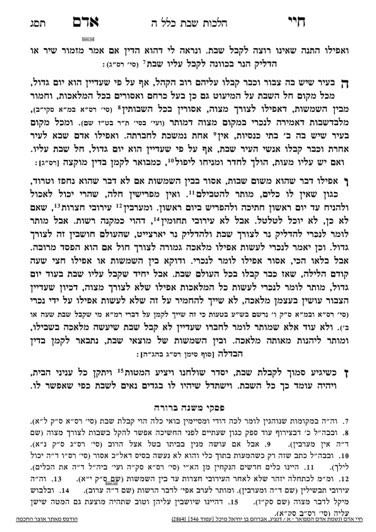We are continuing in siman 6. We have learned that during bein hashmashos, issurei derabanan are muttar for the purpose of a mitzvah or for a significant need. There are certain derabanans, such as hatmana and eruvei chatzeiros, which are muttar regardless.
On the other hand, there are also issurei derabanan which are assur even if one needs to transgress it for the purpose of a mitzvah or significant need. One example is the issur derabanan to create an eruv techumin during bein hashmashos.
Another example is a melacha she’eina tzriacha legufah. In siman 342, the Mishnah Brurah writes that all opinions would agree that a melacha she’eina tzriacha legufah is assur bein hashmashos. According to Tosfos, melacha she’eina tzricha legufah is a melacha in which the action is assur mideoraysa, but a person uses the outcome of the melacha for a different usage than that which it was used in the Mishkan. For example, a person digs a hole. In the Mishkan, they would dig for the purpose of planting herbs for dyeing. Thus, the primary melacha was to dig up the dirt for the purposes of using the ground. If a person were to dig up the dirt for the purposes of using the dirt, it is not assur mideoraysa but assur miderabanan. However, since it is so similar to the issur deoraysa, and the only thing which has changed is the person’s intent, it is assur bein hashmashos as well.
On the other end of the spectrum, we learned that when a person accepts Shabbos as an individual, it takes on a lower level of kabbalas Shabbos than when the tzibbur accepts Shabbos. Alternatively, according to the Shulchan Aruch Harav, we learned that the difference is whether one accepts tosefes Shabbos or kedushas Shabbos atzmo.
Whatever is permitted during bein hashmashos will be muttar during this period as well. In other words, issurei deoraysa are assur, but issurei derabanan are muttar in cases of a mitzvah or significant need (besides for melacha she’eim tzricha legufah). Amira l’achum is muttar as well, but in this situation, we are even more lenient and allow amira l’achum for any purpose, and not just for a mitzvah or significant need. Amira l’yisroel is muttar as well.
Once bein hashmashos begins, amira l’achum will be limited to purposes of a mitzvah or significant need, and amira l’yisorel will obviously be assur.
If the tzibbur has accepted Shabbos, or one accepts kedushas Shabbos atzmah, that acceptance is so binding that even things which were normally muttar during bein hashmashos will now be assur.
Summary
- If one did not accept Shabbos early, during bein hashmashos, it is muttar to perform an issur derabanan for the purpose of a mitzvah or significant need. Additionally, it is muttar to perform amira l’achum on an issur deoraysa during bein hashmashos for a mitzvah or significant need. On the other hand, a melacha she’eina tzricha legufah is assur.
- If an individual accepts Tosefes Shabbos early, anything muttar during bein hashmashos will be muttar during that period as well. Additionally, amira l’achum and amira l’yisroel are muttar for any purpose.
- If the tzibbur has accepted Shabbos, or an individual accepts kedushas Shabbos atzmah, that acceptance is so binding that even things which were normally muttar during bein hashmashos will now be assur.



